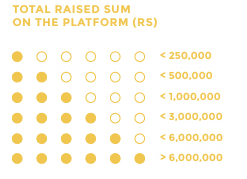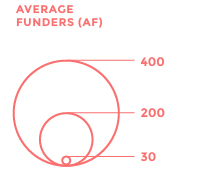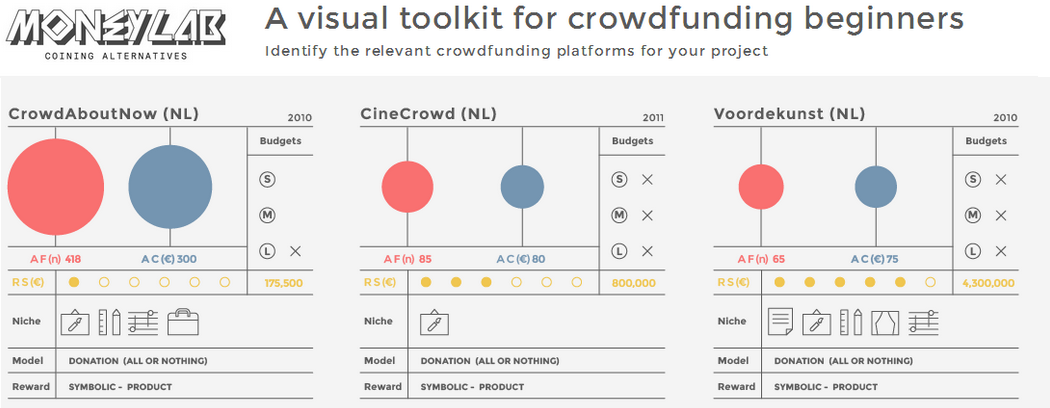What is it?
The Find Your Platform visualization is a database of 60 Dutch and international crowdfunding platforms. You can explore it by playing with a number of filters and sorting options. This allows you to visualize the platforms that are most relevant for your project’s specific needs.
How does it work?
Here’s a 3-step guide to using the Crowdfunding Platform Finder:
1. Click Show filters and select your project category, funding model, reward type and budget size. Multiple selections are possible. Only the crowdfunding platforms that fit the selected criteria will remain visible.
2. You can choose to sort results by average number of funders per project, average financial contribution per funder, raised sums or just default.
3. Click Hide filters in order to explore the results.
You can also opt for no filtering and no sorting. In this case, you can view the entire database of crowdfunding platforms.
Click on any crowdfunding platform to read a short description and see its website.
Click on Show legend to see the figures, abbreviations and visual encodings explained on the spot.
Legend
For each crowdfunding platform, you can view the following data:
i) The type of projects it hosts. There are 8 categories:
Visual arts ![]() film, video, installations and more
film, video, installations and more
Performing arts ![]() theater, dance, a wider range of performance acts that take place in dedicated spaces or improvised ones
theater, dance, a wider range of performance acts that take place in dedicated spaces or improvised ones
Design
![]()
product, fashion, interior, exterior, architecture, identity, digital and more
Technology

applications, tools, platforms and more
Research and Science
![]()
academic papers, experiments, travel costs and more
Creative business
small start-ups and business that have a social and/or creative output
Music ![]() album recordings, concerts, tours, music videos
album recordings, concerts, tours, music videos
Journalism and Publishing ![]() newspapers, online and offline publications and more
newspapers, online and offline publications and more
ii) The crowdfunding model it uses:
Donation – funders are allowed to support projects by donating (no profits expected).
Equity – funders are allowed to invest in projects (expect profits, receive shares etc).
Loans – funders are allowed to lend money to projects (expect loans to be rapid with interest)
Pre–order – funders are allowed to support projects with money and expect a service or product in return.
Subscription – funders are allowed to support projects with money and expect recurring products or services.
iii) The type of reward that campaigns offer there:
Symbolic – funders receive back symbolic rewards such as thank you notes or small objects (T-shirts, cards, etc).
Product – funders receive back a an object/service that is a concrete output of that project (a CD, a ticket, an app etc).
Shares – funders receive a share in the project that they invested in (most common in equity crowdfunding).
None – funders do not receive anything.
iv) Whether it is suited for small, medium or large budgets
Small Budgets – less than 5000 euro
Medium budgets – 5000 to 10000 euro
Large budgets – more than 10000 euro
‘Budget’ refers to the amount of money that campaigns set out to reach (goal amount). It does not refer to the whole budget of the project. It is common for projects to only use crowdfunding to cover part of their budget, whereas the overall budget is much bigger.
v) The total amount of money raised by all successful campaigns
This is the cumulative amount of all campaigns that were successful on the platform. Data was collected early 2014. Currency: euro.

vi) The average financial contribution that a funder gives to a successful campaign
This is an indicative of the amount of money most commonly given by an individual funder to a successful campaign. This is not an average between the lowest and highest financial contributions, but the the most common amount given. To calculate this, we looked at the last 15 successful campaigns.

vii) The average number of funders for a successful campaign
This is an indicative of what number of funders a successful campaign gathers on that platform. To calculate this we looked at the last 15 successful campaigns on that platform. Arguably, this number depends on other factors such as the campaigners’ own network, the effort out into reaching wider audiences, the quality of the project and the incentives.



